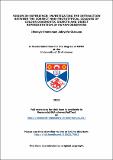Files in this item
Vision in-experience : investigating the interaction between the correct non-prototypical colours of colour diagnostic objects and object representation in human observers
Item metadata
| dc.contributor.advisor | Harris, Julie | |
| dc.contributor.advisor | Jentzsch, Ines | |
| dc.contributor.author | Adeyefa-Olasupo, Ifedayo-Emmanuel | |
| dc.coverage.spatial | xv, 91 p. | en_US |
| dc.date.accessioned | 2015-11-27T10:53:12Z | |
| dc.date.available | 2015-11-27T10:53:12Z | |
| dc.date.issued | 2015-11-30 | |
| dc.identifier.uri | https://hdl.handle.net/10023/7863 | |
| dc.description.abstract | Hering (1964) hypothesized that the representation of a familiar object, which primarily includes its prototypical colour on the visual, conceptual and lexical domains may significantly influence how human observers organize the object’s chromatic attributes – hue, saturation and lightness. Over the past years, studies concerned with the perceptual nature these objects (e.g. Duncker, 1939; Hansen, Olkkonen, and Gegenfurtner, 2006; Witzel, Valkova, Hansen, and Gegenfurtner, 2011) have been able to demonstrate that the colour knowledge which is mentally represented for certain groups of familiar objects does in fact modulate colour perception in cases when human observers are instructed to recover the absolute hue of these objects. Studies have also found that the mental representation of these objects in certain conditions influences the colour perception of unfamiliar objects (Mitterer and Ruiter, 2008). However, it is still a mystery whether the correct non-prototypical colours associated with certain groups of familiar objects are included in the representation of these objects and as a result influence the observer’s ability to recover these objects’ typical hue and typical hue category. Thus, in this thesis, I investigated whether correct non-prototypical colours associated with a certain group of colour diagnostic objects, that is, frequently experienced colour diagnostic objects, influence the human observer’s ability to recover these objects’ typical hue and typical hue category. In order to identify colour diagnostic objects, that is, objects with a constant object-colour conjunction, in the first experiment, observers were presented a range of objects and instructed to select as fast and as accurately as they can the colour they would typically associate with the presented object under normal conditions. The accuracy rate and decision-time scores, which correspond to the conditions a given object must meet in order to be considered a colour diagnostic object, were recorded for each object (Biederman and Ju, 1988). After identifying a group of colour diagnostic objects, an experiential rating scale was implored, with six phenomenological descriptors assigned a numerical value from 0 to 5 with the lowest descriptor assigned an experiential value of 0 and the highest descriptor – always, assigned an experiential value of 5. Objects with high experiential value (≥4) were referred to as frequently experienced colour diagnostic objects while objects with low experiential value (<4) were referred to as infrequent colour diagnostic objects. In the main study, which included four conditions – colour neutral, name neutral, name Stroop, colour Stroop - I measured how quickly observers were able to select the typical hue or typical hue category of achromatic frequently experienced and infrequent colour diagnostic objects, using an object Stroop decision-time task. The object representation of the objects phenomenologically categorized as frequently experienced colour diagnostic objects includes not only the prototypical colour typically associated with these objects but also the correct non-prototypical colour these objects are commonly experienced in. As for the representation of the objects phenomenologically categorized as infrequent colour diagnostic objects, the object representation of these objects only includes their prototypical colour. For this reason, I hypothesized that for the frequently experienced colour diagnostic objects, observers should take longer to recover their typical hue and typical hue category due to these objects’ contextual associations which ultimately facilitates the mental activation of these objects’ correct non prototypical colour. On the other hand, for infrequent colour diagnostic objects observers would be quicker in recovering the objects’ typical hue and typical hue category as the activation of these objects’ colour is non-contextual, which therefore leads to the activation of a single colour. In one out of the four conditions, results for the object Stroop decision-time task demonstrated that observers on average took longer to recover the typical hue but not the typical hue category for the frequently experienced colour diagnostic objects when compared to the infrequent colour diagnostic objects. In general, results from this study support the idea that the object representations of colour diagnostic objects not only include their prototypical colour on multiple domains (Naor-Raz and Tarr, 2003), but that their correct non-prototypical colours may also may be represented on the conceptual and lexical domain, additional information human observers are able to use as they quickly attempt to recognize these objects in atypical perceptual conditions. | en_US |
| dc.language.iso | en | en_US |
| dc.publisher | University of St Andrews | |
| dc.subject | Correct-non prototypical colours | en_US |
| dc.subject | Object representation | en_US |
| dc.subject.lcc | BF789.C7A3 | |
| dc.subject.lcsh | Color--Psychological aspects | en_US |
| dc.subject.lcsh | Color vision | en_US |
| dc.title | Vision in-experience : investigating the interaction between the correct non-prototypical colours of colour diagnostic objects and object representation in human observers | en_US |
| dc.type | Thesis | en_US |
| dc.type.qualificationlevel | Masters | en_US |
| dc.type.qualificationname | MPhil Master of Philosophy | en_US |
| dc.publisher.institution | The University of St Andrews | en_US |
This item appears in the following Collection(s)
Items in the St Andrews Research Repository are protected by copyright, with all rights reserved, unless otherwise indicated.

